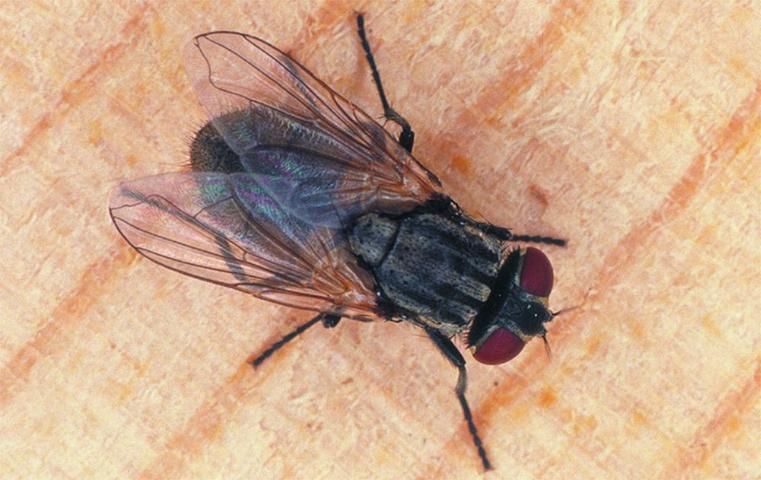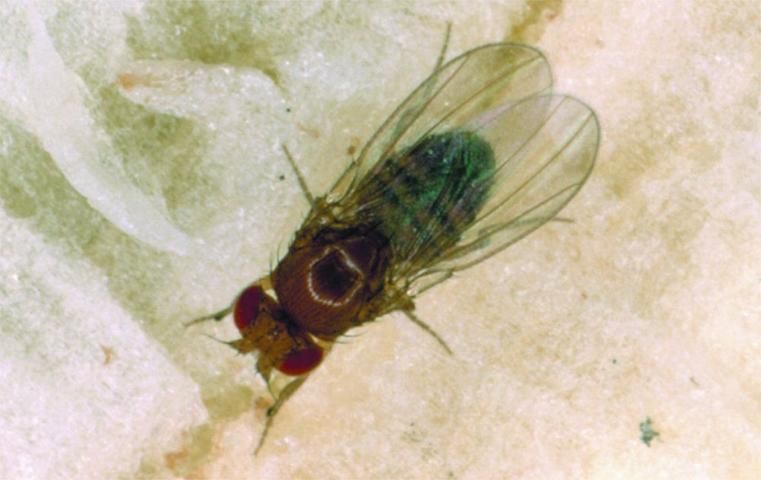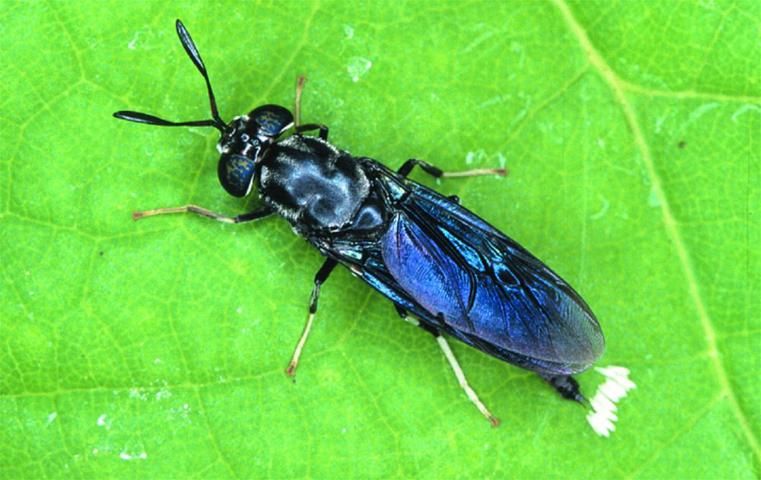Filth-breeding flies are annoying and are important vectors of disease. The larvae usually are found in excrement, decaying vegetable matter, rotting meat or garbage. They are strong fliers and often enter the house in search of food or moisture. They have sponging-lapping mouthparts and ingest only liquids.
House Fly, Musca domestica
The house fly is 4 mm to 6 mm long, gray to black, and the thorax has four black stripes. The fourth wing vein has a sharp upward bend to almost join the third vein at the tip of the wing. The fly prefers to breed in decaying animal excrement but will also develop in garbage and vegetable waste. High populations are sometimes found close to poultry and livestock facilities.

Greenbottle Fly, Phaenicia sericata
The greenbottle fly is 10 mm long and metallic green with no stripes on the thorax. The bristles on top of the thorax are large, and the front of the thorax is covered with whitish pollen dust. The anterior spiracle is dark. It prefers to live on dead animals, garbage, and high-protein fecal material. It is prevalent in dog stools.

Bluebottle Fly, Calliphora vomitoria
The bluebottle fly is 10 mm long, the thorax is dull, and the abdomen is metallic blue-green. There are no stripes on the thorax. The bristles on top of the thorax are small. The anterior spiracle is red. It breeds in dead animals and garbage.

Secondary Screwworm Fly, Cochliomyia macellaria
The secondary screwworm fly is 10 mm long with the thorax and abdomen metallic green and shiny. The thorax has three stripes of equal length. It breeds in decaying animal flesh.

Vinegar fly, Drosophila melanogaster
The Vinegar fly is 3 mm long and can enter houses through normal screening. The fly has a tan head and thorax and a black abdomen. Its larvae feed on yeast in the fermenting fluids of decaying fruit and vegetables. It is common wherever these items ferment and rot.

Flesh Fly, Sarcophaga spp.
The flesh fly is 8 mm long, dull-grayish with three stripes on the thorax. The abdomen has a gray checkerboard pattern. Many species have a red tip on the abdomen and red eyes. It breeds on decaying meat, fish and garbage. The fly lays live larvae on meats and scraps.

Moth Fly, Psychoda spp.
The moth fly is 2 mm to 3 mm long and is tan to grayish. The wings are without cross veins and mottled with black and white. The antennae are 13-segmented and have a puff of hairs on each segment. It breeds in sewage filter plants and is often called a filter fly. It also breeds in moist areas in the house, such as clogged overflow pipes of sinks and tubs; therefore, it is often called a drain fly.

Eye Gnat, Hippelates pusio
The eye gnat is 2 mm to 3 mm long and is shiny black. It breeds outside in decaying vegetable matter. The fly frequently feeds around the eyes and causes irritation and annoyance. Injury to the eye can be caused by spines on the mouthparts.

Humpbacked Fly (family Phoridae)
The humpbacked fly is about 3 mm long with a dull-black body. The antennae are one-segmented. Wings have three posterior veins with no cross veins. It breeds in high-protein decaying organic matter. Residues in trash cans and drains are the most frequent areas of breeding. It is frequently found in hospitals, nursing homes, and supermarkets.

Soldier Fly, Hermetia illucens
The soldier fly is about 15 mm long and is wasplike in appearance. The abdomen has two whitish areas near the base. It breeds in wet animal feces and commonly invades the house through the toilet from infestations in the septic tank or broken sewer lines.
